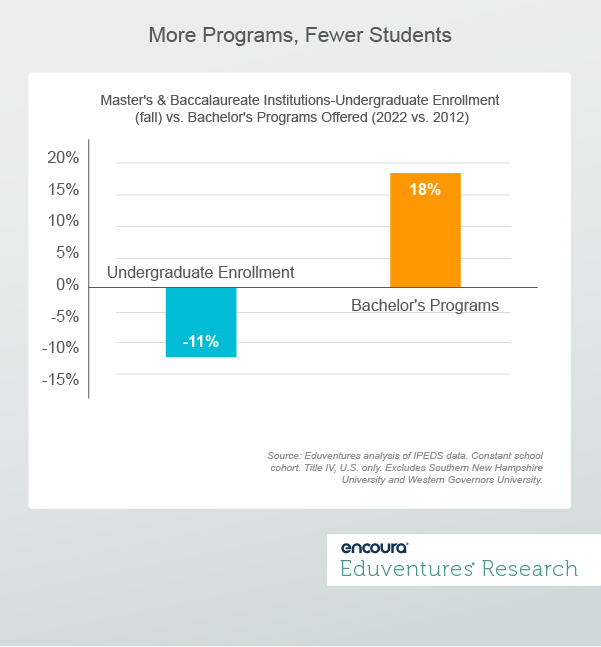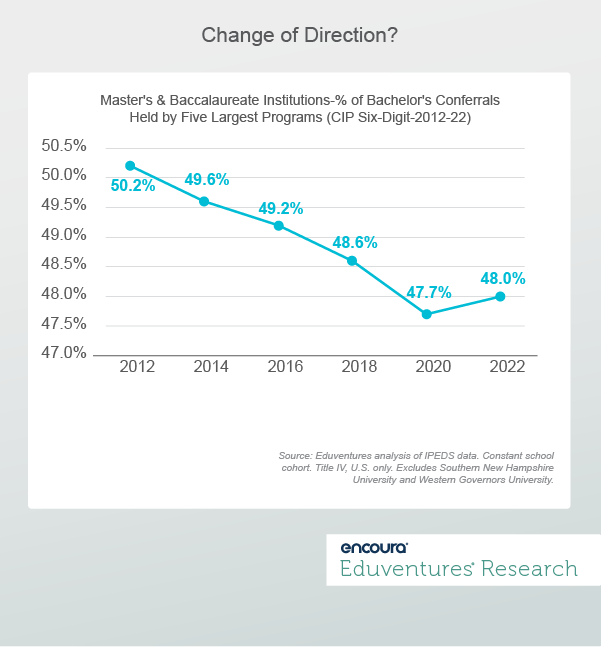Last week, we introduced my 2024 predictions, with a deep dive into the first two predictions centered around the power of AI and short-term pell grants.This week, we’re focusing on my third and final prediction. ICYMI: I predicted that 2024 will mark the turning point toward greater bachelor’s programs among institutions, particularly schools struggling with enrollment. This is a departure from the past decade’s emphasis on volume and variety.
So, after decades of diversification, will specialization be the new bachelor’s strategy? Let’s examine the impact of new programs.
Prediction 3: A New Bachelor’s Era—from Variety to Focus
Eduventures’ Bachelor’s Market Update series has tracked the steady growth in the total number of bachelor’s degree programs offered by U.S. colleges and universities. Between 2012 and 2022, there was a net increase of over 11,000 programs for a total of just under 75,000, up 18%. Many schools launched more programs but continued to lose students.
This is unsustainable and non-strategic.
Academic program diversification can make sense: a broader portfolio may appeal to a wider array of prospective students and hedge against the ups and downs of specific fields and industries. New programs can help a school keep up with new trends and technologies.
But there are tradeoffs. More programs raise operating costs, requiring new faculty and equipment. A larger program portfolio may become unwieldy, blurring institutional identity and diluting distinctiveness.
New programs are often a response to weak enrollment, but diversification is not working. Figure 1 compares undergraduate enrollment and bachelor’s programs growth at public and private nonprofit master’s and baccalaureate institutions—the sectors among the most challenged on the enrollment front.
Figure 1.
More bachelor’s programs may have limited enrollment decline, but certainly did not reverse it. On average, schools now have more lower-performing programs.
More bachelor’s programs did not, in fact, mean more diversity by main field of study. On average, the typical baccalaureate or master’s institution was active in 16 main fields of study over the past decade, and this has remained unchanged (out of 32 main fields tracked by the U.S. Department of Education, excluding six tiny main fields at the bachelor’s level). Schools dropped out of some fields and added others, but net diversity remained constant.
Over the same period, while lots of new bachelor’s programs were added, the share of bachelor’s conferrals at master’s and baccalaureate schools held by the five largest bachelor’s programs (at each school at the CIP six-digit level) ticked down (see Figure 2).
Figure 2.
In 2012, the top five programs accounted for 50.2% of bachelor’s degrees conferred at these schools, falling steadily to 47.7% by 2020. Program diversification had a (modest) impact.
But then something unexpected happened: the top five programs regained share in 2022 (hitting 48%).
I think this is significant and the start of a new trend. This resilience among the largest programs is a reminder that some opportunities are much bigger than others, and that focus can pay dividends.
To thrive amid fewer high school graduates and a depressed college-going rate, a crashing adult market and a crowded online space, schools need to double-down on areas of strength, trim marginal programs, and stand out from the crowd. It is unsustainable to keep adding new programs without cutting elsewhere and suboptimal that some in-demand programs (e.g., nursing, computer science) suffer from lack of supply. It’s better for schools to focus strategically with time on their side to avoid being plastered on the front page of Inside Higher Ed accused of hasty cuts and lack of consultation.
I predict that the forthcoming 2022/23 IPEDS data will show evidence of renewed bachelor’s program focus from institutions:
- The total number of bachelor’s programs offered by master’s and baccalaureate schools will fall for the first time since IPEDS began tracking program numbers in 2012.
- The average number of main fields of study offered by these schools will fall below 15—also unprecedented.
- The share of bachelor’s conferrals at these schools held by their five largest bachelor’s programs will grow for the second year in a row, reversing the long-term trend.
Of course, such “deep” trends shift only gradually, and variety versus focus is relative. Under the right circumstances, greater program diversification can be a winning model. I am not predicting (or recommending) that the average school becomes super-specialized. The appeal of a liberal arts education is timeless, even if today’s version would benefit from greater focus and structure.
What I am predicting is that most schools will make greater headway this decade by underlining what they are best at rather than chasing fashions or trying to be all things to all students.
For more analysis of the bachelor’s market, look out for Eduventures’ latest Bachelor’s Market Update report coming in 2024. The Eduventures Program Strength Assessment and Program Exploration Study tools are great ways for clients to get a grip on programming.



